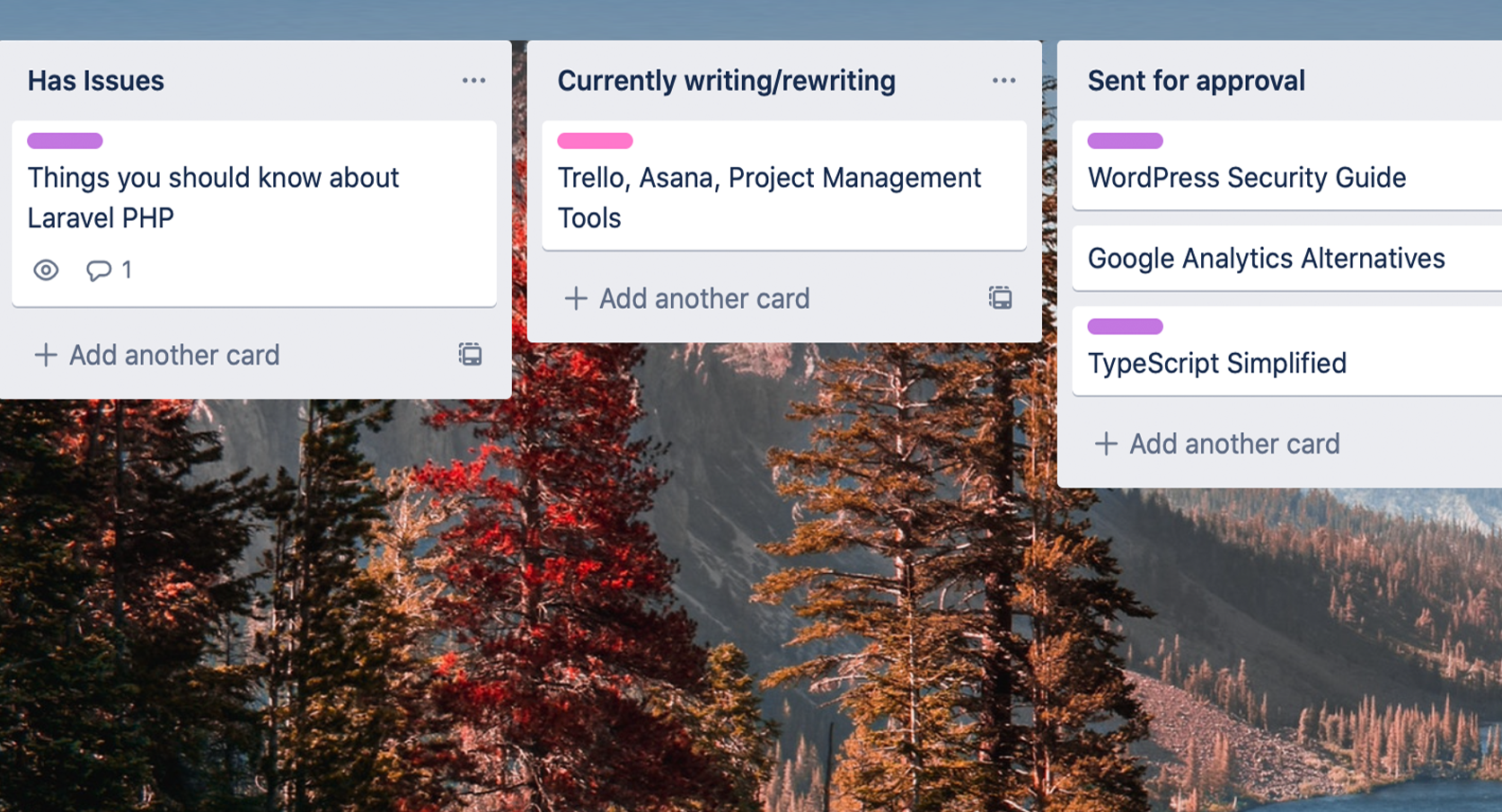Overview
Ever since the “invention” of the digital Kanban in 2011, project management software has been springing up everywhere. What are your options?
.webp?updated_at=2023-07-25T07:23:18.227Z)
If you’d asked the average business owner what a kanban board was in 2010, you would’ve gotten—at best—a half-remembered factoid about the Toyota shop floor. Less than a year later, they were already well on their way to taking over tech. Joel Polsky’s 2011 TechCrunch presentation of an early version of Trello immediately generated a huge amount of interest and venture capital, and now in 2020, some variation of their digital kanban has become an integral part of tech and business management.
Today we’re talking kanbans specifically, and project management software more broadly. What’s the right choice to make for your company? Let’s go over the options.
Trello
Trello is the original digital kanban, and it has managed to stick around as one of the major players in the scene. It hasn’t really changed much since it was first developed, but it doesn’t need to: it’s simple and flexible and (for the most part) free. Trello is a kanban board … and that’s it. Almost every other tool we’re discussing here is a project management tool with kanban functionality, but Trello is just the boards, as stripped-down and elegant as possible.
A few years ago I spent a month trying out various management software, spending a week each with Trello, Meistertask, Asana and Zoho. I ended up sticking with Trello, and I’ve used it at every job since—when the volume of works-in-progress is high, it’s an absolute lifesaver. Trello lacks the features of many of the other software suites, but it has all the features I found myself actually using:
- Easy drag and drop interface
- Highly customizable
- Color-coded labelling
- Due dates
- Commenting and collaboration

It’s not a perfect fit for every job, and it can get a bit chaotic with multiple users. It’s an excellent small-scale tool, but I don’t recommend it for running a company. I tend to build private, personal kanbans in Trello and use other tools for collaboration. Speaking of:
Asana
Asana is a lot more full-featured than Trello, and designed to handle larger teams. It has a great task dependency management system that lets you specify that task x is waiting on task y, laid out in a clear and appealing style. The key term to take away from Asana is integration—each element of Asana synergises beautifully with each other element. No more busywork repeating yourself: you put a task on the kanban, it shows up on the calendar and the timeline and everywhere else that it’s appropriate.
The more staff and the more elements you need to keep track of, the better Asana becomes. I’ve generally worked in teams of 3–5 and we had an okay time with Trello, but it proved woefully insufficient in a team of 30 and I was glad we switched over to Asana instead. For teams of 500 or 1000 it’s even better. It hits a nice balance where it gives you a huge amount of information without overwhelming you.
Asana’s pricing is a lot more aggressive than Trello’s—you can happily work on Trello’s free version without ever needing to upgrade, but the basic Asana package lacks a lot of key features. The timeline is restricted to the premium version ($10.99/month per person), and its more powerful features like portfolios are only in the business package ($24.99/month pp). It definitely lets you do more aMeisterTasknd handle more than Trello, but if you want to get anything out of it you’re going to need to be willing to pay.
MeisterTask
I’m on the fence about MeisterTask these days. Back when I was using it a lot in 2016 it was the undisputed analytics king with its performance and time tracking, but Asana has caught up and now MeisterTask sits in a bit of a strange place in the ecosystem. As-is, it’s a sort of medium space between Trello and Asana in terms of size and power. It’s a kanban board with analytics and timeline capability, but without a lot of Asana’s broader business functionality. Their pro plan is $8.25/person/month and their business plan is $20.75/person/month, so it has a competitive edge on Asana if you’re looking for a middle ground.
Jira
Jira is what we like to call a ‘specific use-case’. It’s good if you’re a software development team and very good if you’re an Agile software development team, but confusing and overengineered otherwise. I’d feel incomplete leaving it out (it’s most engineers’ favorite piece of project management software, it often gets requested in tech job ads, and it’s one of the most popular tools around) , but you need to be aware that it’s a specialist tool and you’re going to spend a lot of time fighting against its features if you try to use it elsewhere.
Since it’s designed very specifically with Agile in mind, it comes with specialist Scrum boards and sprint functionality as well as detailed analytics reporting to help you keep track of project progress.
Zoho
Zoho is a CRM for small and medium businesses, but it comes with built-in kanban functionality. You can switch from list view to kanban view, which will place data on cards ordered by lead status. I’m not sure I’d recommend it as a sole workflow management tool (it’s a CRM—it’s great for managing customer relations and everything else is a side-benefit), but I know many of our clients are already using it but are unaware that they have they have a kanban option hidden away. It’s fairly limited compared to a lot of our other options, but if it’s what you need then it’s what you need.
Monday
Monday is trying to be everything: a little bit Trello, a little bit Slack, a little bit Jira. It’s trying to be a little bit of everything, but that means it’s not really great at anything. Monday is tremendously complete, but it’s more of a jack of all trades. Monday has a fairly outsized marketing presence online (if you’ve watched YouTube without an adblocker in the last few years, you’ve almost certainly run into them) but they’re yet to make a huge impact in the project management space. I’m curious about whether that’s going to change—they seem to be picking up a little momentum and they may be a bigger player in a few years. Right now they’re just a little too monolithic, trying to do everything and not really shining in any particular way.
Something like Jira is also big, but it’s laser-focussed in what it wants to do and I don’t always get that same sense from Monday. That may well change, and I think it’s worth keeping an eye on them. They do have a free trial if you want to try them out yourself and see how you feel.
Redmine
Redmine is harder to use than a lot of this software, but it’s open-source, free, and exceptionally powerful and versatile. It’s the oldschool platform that a lot of these other pieces of software are obviously based on. It requires a bit of engineering knowledge to make it work, but if you’re the sort of person who would rather a box of loose lego pieces over pre-built spaceships then Redmine might be the thing you’re looking for.
TickTick
I hadn’t heard of TickTick before I started writing this article, but I spent some time talking with the team and a few of them all mentioned the same little piece of software that helps them stay organised. I spent a little time this afternoon playing around, and I love it. TickTick is basically the best sticky note app ever made, with built-in kanban functionality. It’s not as pretty as Trello and doesn’t let you decorate and customize to the same extent, but it’s just lightning-fast, incredibly simple, and it just works. Like Trello it seems like a better choice for personal organisation rather than teams, but I really like how elegant it is and I’m planning to use it more in future.

Wrapping Up
In ten short years, kanban boards and other organisational tools have taken over the industry, and it’s easy to see why. We deal with more data and bigger teams every day, and it’s becoming harder and harder to keep track of. Kanban boards and management tools can help, and at CodeClouds our software development teams use a variety of different tools depending on what suits their projects best- there’s no one right answer.
Share this article
148 reads
Similar Reads








